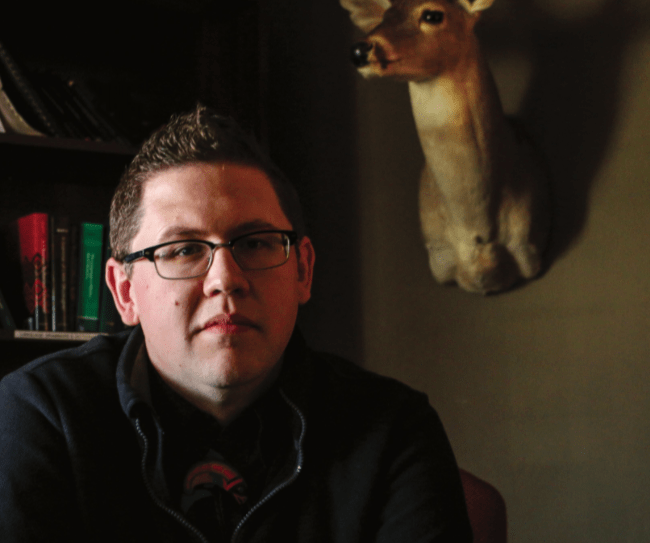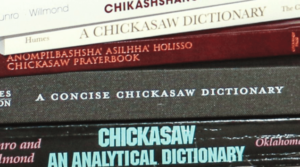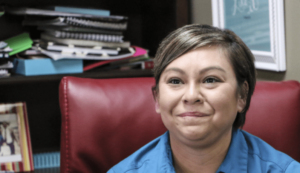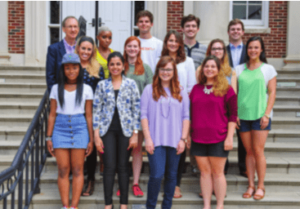Headlines
Unconquered and Unconquerable: The Race to Save a Language

Josh Hinson may look like an Irishman, but he is devoted to saving the Chickasaw language.
The Chickasaws know that to lose their native tongue would be to lose a big slice of who they are. And the clock is ticking.
Josh Hinson looks like an Irishman. In fact, in the Chickasaw tribe’s annual Three Sisters Festival, he plays the role of the white trader.
“It’s my burden. It’s my cross to bear. The whitest guy who can talk Chickasaw.”
Despite appearances, Hinson is part of a small army of people devoted to rescuing the Chickasaw language from the approaching threat of extinction.
In fact, most would consider Hinson the general of this army – a role for which he is respected within the tribal community.
“Yeah. Speakers are like rock stars,” he says.
He is referring not to himself but to fluent speakers of the Chickasaw language, those who learned to speak it first, before learning English. There are fewer than 50 alive today.
The language is in a dire state. With the youngest fluent speaker already 70, the Chickasaws face the threat of not only losing their native tongue, but the ancient knowledge and cultural understanding so deeply embedded within it. To lose a language is to lose a large piece of a tribe’s cultural pie. Time and mainstream society have greedily eaten away at it. But the Chickasaws are determined to piece together the crumbs that are left.
Sixty-five years ago, Stanley Smith walked from home to a one-room schoolhouse. He was a young Chickasaw boy in Allen, Okla., and it was his first day of school.
 It was also his first encounter with the English language.
It was also his first encounter with the English language.
Smith was just one of 50 Chickasaw classmates. There were around six white students. The teachers spoke only English.
Along with Indian students who were mostly kinfolk, they struggled to learn the strange language their lessons were taught in. They struggled to communicate with classmates. They struggled to assimilate into the new culture being forced upon them.
“It was hard. But we all helped each other,” Smith said.
In 1880, the U.S. government began requiring Native American children to attend boarding schools or neighborhood schools aimed at casting off tribal influence and assimilating them into mainstream American culture. In these schools, many of which adhered to one founder’s slogan, “Kill the Indian, save the man,” children were often forbidden to speak anything but English. At the time, these trials led many Chickasaws to view their native language as a burden. Many eventually quit speaking it.
This tale is the tale of many tribes sent to government schools after removal to Oklahoma. As a result, the Chickasaws are just one of many on the verge of losing their native tongue because of the struggles students like Stanley Smith faced. Those struggles led to a burning desire to make life easier for their children. And to them, easier meant speaking English. And only English.

When Stanley Smith was a young boy, his grandfather told him never to forget how to speak his beautiful language.
Now that Chickasaw isn’t being taught in every home, it’s up to people like Smith to teach people like Hinson all they know before time runs out. And the clock is definitely ticking.
Easier said than done. Learning Chickasaw entails learning a poly-synthetic language. Whereas English is analytic with a noun, then a verb, and so on, Chickasaw consists of a verb that sits in the middle of a huge word with other stuff attached to it. This one word may be a couple of sentences in English.
For example, ‘Ilooittibaa-áyya’shanattook’ means “we all, more than three, were there, in that place, in an ongoing way, a long time ago, more than a year ago.”
“Turning that over in your head and thinking that way is tough,” Hinson says. “If it takes 15 hundred contact hours to be really good at communicating in Spanish, it takes probably 6,000 to 8,000 contact hours to be really good communicating in Chickasaw. It’s easily as hard as any of the most challenging world languages like Russian or Mandarin Chinese. It’s harder.”
So what possessed him to devote his life to learning and teaching such a difficult language?
Born and raised in West Texas, Hinson grew up removed from the tribe and its culture. What little knowledge of the language he held came from Granny Meme. She couldn’t speak much of her native language herself, but gave her grandchildren Chickasaw dictionaries for Christmas when Hinson was around 8 years old. His copy sits in his office today.
“We would give ourselves names and try to make up sentences… ‘cause we didn’t know what we were doing.”
He’s come a long way. Studying art history for his master’s degree at the University of New Mexico got Hinson interested in the language. He started learning in 2000, went to work for the tribe in Oklahoma in 2004, and says he was able to communicate “pretty well” by 2006. He has four sons—two adopted, two biological.
“When my first biological son was born, I just started really seriously picking up the language. It seemed like a good way to sort of figure out the cultural side of things,” he says.
 Unlike the many Chickasaws who stayed in Oklahoma surrounded by their culture, when Hinson moved there, he felt disconnected from the tribe.
Unlike the many Chickasaws who stayed in Oklahoma surrounded by their culture, when Hinson moved there, he felt disconnected from the tribe.
“Yeah, like an outlander born and raised in Texas,” he says. “No significant cultural knowledge. Getting the language just sort of, like, sucks you to the center… where it doesn’t matter.”
His job title is director of the Chickasaw Language Revitalization program, in which Smith is also active. Smith taught Hinson, and now together they strive to teach others. It is an increasingly urgent mission.
“We have to get good really quick. We don’t have time to mess around,” Hinson says. “We need to get good, when we can sit right next to fluent speakers and they can say, ‘Well, you might want to say, like, this.’”
The Chickasaw Academy is an intense, full-time language program in which tribal members immerse themselves in the dialect: a two-year long program, five days a week, five hours a day. For those who can’t participate in the revitalization classes, a Rosetta Stone program is being produced, the first 40 lessons of which will be released in fall, 2016. Additionally, the Chickasaws have created apps for tribe members to learn on their own anywhere, anytime. Andrea Kihega is a student in the immersion classes. Having always been interested in her heritage, she decided to study her native language. Kihega and the other students are encouraged not to use notes, only their memories. And while she says that she has struggled to break out and become confident in speaking the language, four years have made her knowledgeable enough to text in Chickasaw.
“I am so thankful today that I can still speak my own language,” Smith says. “I can remember Grandpa told me when I was 6 or 7 years old … ‘Don’t ever forget your language.’ I always think about that and how Grandpa said it’s a beautiful language.”

Andrea Kihega is a student in the immersion classes. She now knows enough to text in Chickasaw.
When Smith and other Chickasaws sought to make life easier for their children by not burdening them with two languages, they never dreamed that it would so quickly lead to today’s drought of fluent speakers.
Once, Hinson was somewhat the same way. He regrets that he wasn’t prepared enough to teach the old language to his newborn.
“I was a coward when the baby was born. I just didn’t feel I was proficient enough to raise him in it. He didn’t have the opportunity to be immersed in it ‘cause I just didn’t feel like I was qualified.”
In a world ruled by English, it will prove difficult, if not impossible, to develop a large core of people who speak Chickasaw first, English second. But perhaps the seed planted within the five people in Hinson’s immersion program can ignite a desire to learn that spreads throughout the tribe. The thought brings a smile to Hinson’s face.
“If we could just get, like, one percent before I die, one percent of the tribe as conversational speakers… Man, that would just be, I can’t even imagine, it’d be super,” he says.
Then, with squinted eyes, he starts pointing and bouncing fingers and running through the math.
“Shoot. It’ll never happen. That’s my wildest dream.”
Reality strikes and he lowers the bar a little. “You know, I’ll just take, I’ll take 10 right now. If we could get 10, highly proficient, second language learners.”
And with the vigorous efforts being made, it looks like he can prevail. More importantly though, the lesson has been learned. The severity of how much tribal culture is bound by language has been realized. If you don’t understand the language, you can’t fully understand the culture.
“There’s really something, sort of this world view, about how our ancestors, and our traditional people view the world that you just can’t have access to in some ways without knowing the language,” Hinson laments.
Walk the grounds of the spacious Chickasaw Cultural Center, a colorful, informative repository of tribal history, and you will frequently hear people offer greetings in Chickasaw. Here and there, more often, people use phrases and sometimes a sentence or two. There is a definite charge of hope running through the Chickasaws today. And maybe Hinson arrived at just the right time to be a big part of that.
As he thinks about it, a big smile spreads across his face.
“The traditional folks don’t care that I don’t look how an Indian ought to look. Because I can speak Chickasaw.”
By Kate Hayes. Photography by Chi Kalu.

LEFT TO RIGHT: Ariel Cobbert, Mrudvi Bakshi, Taylor Bennett, Lana Ferguson, SECOND ROW: Tori Olker, Josie Slaughter, Kate Harris, Zoe McDonald, Anna McCollum,
THIRD ROW: Bill Rose, Chi Kalu, Slade Rand, Mitchell Dowden, Will Crockett. Not pictured: Tori Hosey PHOTO BY THOMAS GRANING
The Meek School faculty and students published “Unconquered and Unconquerable” online on August 19, 2016, to tell stories of the people and culture of the Chickasaw. The publication is the result of Bill Rose’s depth reporting class taught in the spring. Emily Bowen-Moore, Instructor of Media Design, designed the magazine.
“The reason we did this was because we discovered that many of them had no clue about the rich Indian history of Mississippi,” said Rose. “It was an eye-opening experience for the students. They found out a lot of stuff that Mississippians will be surprised about.”
Print copies will be available October 2016.
For questions or comments, email us at hottytoddynews@gmail.com.
Follow HottyToddy.com on Instagram, Twitter and Snapchat @hottytoddynews. Like its Facebook page: If You Love Oxford and Ole Miss…





























